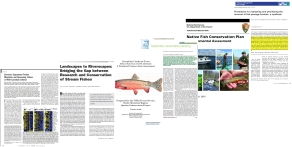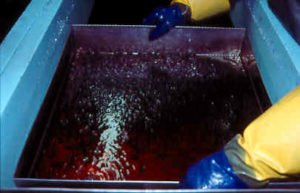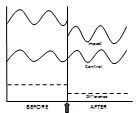You will find hereafter some examples of tools we frequently use to tackle most efficiently the questioning and problems of managers. We transfer on a regular basis tools from research and adapt them to the needs of on-site managers, and our ongoing scientific collaborations enable us to propose specific tools for any of your issues.
 Bibliographic research is a must to answer any new questioning regarding management issues. It is the foundation of our activity…
Bibliographic research is a must to answer any new questioning regarding management issues. It is the foundation of our activity…
Bibliographic search is a must to answer any new questioning regarding management issues. It is the foundation of our activity interfacing science and management, and is thus integrated to our work approach. We have developed a progressive approach in six distinct steps. The goal is to review on a global scale the studies that are already published on any given subject. All new management questioning is legitimate, but it does not necessarily need a new study. One needs to know first of all whether or not such a study has already been conducted and exists in the available scientific literature. For managers, this means potentially cost and time saving by the use of an already available scientific research. If a study proves itself needed, using bibliographic research will enable us to focus on best practices, available tools and obtained results. All this information helps us build together with the managers a coherent scientific project with maximum efficiency, and with the most pertinent and operational results possible.
 Tools used in population genetics can have multiple applications in management programs. Usually, population genetics…
Tools used in population genetics can have multiple applications in management programs. Usually, population genetics…
Tools used in population genetics can have multiple applications in management programs. Usually, population genetics is used in conservation programs to identify native populations and for the definition of coherent management units. However, other and lesser known applications exist. Genetic tools allow for estimating abundance of a population, or identifying populations most at risk. It can study habitat fragmentation, evaluate the efficiency of restoration actions and follow-up on actions on restoring fish migration… Building on its experience of conservation and restoration of native trout population (see our scientific publications), SCIMABIO offers its expertise to project holders and develop tailored solutions to encountered management issues.
 Often used to evaluate the contribution of restocking to fish stocks, mass-marking relies on a variety of methods…
Often used to evaluate the contribution of restocking to fish stocks, mass-marking relies on a variety of methods…
Often used to evaluate the contribution of restocking to fish stocks, mass-tagging relies on a variety of methods. Fluorescent marking provides added benefits with no direct mortality and is easy to deploy, when certain conditions are met. The fluorescent marks are long-lasting when set in the otoliths (small bones found in the head of most fish), and can be observed under a fluorescence microscope after a careful preparation of the sample. Single or multiple marks can be envisioned, thus allowing to differentiate origins or stocks and test a number of management scenarios (PDF). In a situation where specimens cannot be sacrificed, we can offer alternate marking methods, using calcein for example. This fluorescent marker concentrates in fins (PDF) and is visible in the dark with a US patented portable device. For more information, you can read our technical focus on the matter.
 SCIMABIO relies on a very large body of experience in using transponders (PIT-tag) and in setting up RFID technology…
SCIMABIO relies on a very large body of experience in using transponders (PIT-tag) and in setting up RFID technology…
SCIMABIO relies on a very large body of experience in using transponders (PIT-tag) and in setting up RFID technology applied to fish. This technology has been used for decades in scientific programs but its development in management areas is quite recent. Its operational application isn’t straightforward, and requires certain skills to handle the equipment involved. Scientific support is essential at all stages of the project to ensure suitable devices and their functioning along the way, as well as for the collection, analysis and validation of gathered data. SCIMABIO functions as knowledge brokers and specialists in technological transfer between science and management. We share our skills in this new area (more details in our technical focus).
 Telemetry consists in following tagged specimens from afar. It demands on the one hand to tag specimen with…
Telemetry consists in following tagged specimens from afar. It demands on the one hand to tag specimen with…
Telemetry consists in following tagged specimens from afar. It demands on the one hand to tag the specimens with transmitters and on the other hand to have fixed or portable receivers to collect and record the signals emitted by the tagged specimen. Several technologies have been developed for different situations (lacustrine, marine or freshwater environments, species under consideration, size and amount of specimen to tag, length and geographical areas…). Surgical marking consists in implanting transmitters in the fish’s abdomen, and is considered the least intrusive method. It still is a surgical act, and thus is highly regulated and must be performed by qualified and experienced staff with all the necessary technical and sanitary precautions. We are authorized to perform surgical marking of fish and SCIMABIO is being approved to uphold projects on animal experimentation for scientific means. We offer several implications in telemetric monitoring projects, form the design phase, choice of technology, tagging, setting-up of receivers, and up to data analysis.
 In addition to fluorescent markers and PIT tags, we can offer several other methods of individual- or mass-marking depending on…
In addition to fluorescent markers and PIT tags, we can offer several other methods of individual- or mass-marking depending on…
In addition to fluorescent markers and PIT tags, we can offer several other methods of individual- or mass-marking depending on the desired goals. Indeed, numerous extrinsic (produced by an operator) or intrinsic (naturally acquired) markers exist, and new technologies applied to management issues are being developed (visible or coded implants, external marking by tissue removal or coloration, genetic or isotopic markers…). The success of a marking project relies on three components: 1/ the choice of the marking method must be commensurate with the objectives to be achieved and the technical constraints, 2/ the implementation of an on-site protocol with precise rules, which may differ according to the chosen marking method, but must ensure the quality of the harvested data, 3/ the treatment and analysis of the data which will allow for the best results in answering the initial questions. SCIMABIO can assist you in this process.
 Scales and otoliths are calcified structures frequently used to analyze fish growth. The procedure, called sclerochronology…
Scales and otoliths are calcified structures frequently used to analyze fish growth. The procedure, called sclerochronology…
Scales and otoliths are calcified structures frequently used to analyze fish growth. The procedure, called sclerochronology, consists in identifying slower growth periods consistent with winters, and to deduce from there the age of the specimen and their growth curve. Otoliths are also analyzed when fluorescent markers are used, to identify the mark (see technical focus). Moreover, otoliths geochemistry being linked with the surrounding environment, the use of isotopic markers potentially allows to track back the ecology of specimens though different stages. Contact us if you want more information on these techniques.
 The BACI method (Before-After-Control-Impact) has initially been developed in the late 90’s to evaluate the efficiency of ecological restoration actions…
The BACI method (Before-After-Control-Impact) has initially been developed in the late 90’s to evaluate the efficiency of ecological restoration actions…
The BACI method (Before-After-Control-Impact) has initially been developed in the late 1990’s to evaluate the efficiency of ecological restoration actions. This method is very well suited for “before-after” monitoring in assessing the environmental impact of all actions. It can be used in whatever domain : restoration works, restoration of ecological continuity, change in management method, evaluation of rivers contracts… It is valid for whichever indicators chosen, whether quantitative or qualitative (physico-chemical, habitat, hydrobiology, fish, genetics…). In opposition to the widely used comparative method, this approach allows for a precise and detailed view of the change that took place. We offer tailored designs depending on the action you wish to engage, and we can assist you in setting-up, monitoring and analyzing the results.
 Population viability analyses are aimed to evaluate the threat level on populations…
Population viability analyses are aimed to evaluate the threat level on populations…
Population viability analyses are aimed to evaluate the threat level on populations, the probability of extinction or decline, and to prioritize the most endangered populations in order to set priorities for action. These analyses make for a crucial step in any conservation or biodiversity restoration project.
 We have developed a particular process to ecologically diagnose a river basin on a principle of “landscape to riverscape”…
We have developed a particular process to ecologically diagnose a river basin on a principle of “landscape to riverscape”…
We have developed a particular process to ecologically diagnose a river basin on a principle of “landscape to riverscape” issued by Kurt Fausch in the early 2000s. Our premise would be that it is illogical to set-up ecological diagnoses with similar protocols and methods on rivers and river basins with very different features (in terms of land-use, geology, potential impacts, wildlife and habitats…). Why indeed use identical indicators, methods and quality thresholds on a river in Normandy and an alpine river? This unifying approach of methods and protocols leads to imprecise, even false results that will not allow the identification of limiting factors specific to the studied basins. With the diversity of situations, habitats and impacts, it is thus necessary to answer with a diversity of methods, tools and approaches to adapt to local conditions. Our way of diagnosing and monitoring is indeed adaptive and dynamic in space and time. We support project managers that wish to implement on their territory a consistent approach in management and data harvesting.
